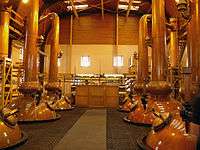Littlemill distillery
|
The Littlemill distillery after it was dismantled | |
| Region: Lowland | |
|---|---|
| Location |
Bowling, West Dunbartonshire 55°55′52″N 4°29′47″W / 55.931167°N 4.496306°WCoordinates: 55°55′52″N 4°29′47″W / 55.931167°N 4.496306°W |
| Owner | Loch Lomond Distillery |
| Founded | 1772 |
| Status | Demolished |
| Water source | Kilpatrick Springs |
| Mothballed | 1929 to 1931, 1984 to 1989 |
| Demolished | Dismantled in 1997, burned down in 2004 |
Littlemill distillery was a Scottish malt whisky distillery in Bowling, West Dunbartonshire. Situated on the border of Lowlands and Highlands, its products were generally classified as lowlands whisky.[1] The year when whisky was first produced is uncertain. Littlemill was described as part of the purchase of Auchentorlie Estate in the 1750s. In 1772 houses had been constructed for excise officers, which is also the year Littlemill claimed as its foundation year, from which it claimed to be the oldest distillery in Scotland.[2][3]
The distillery changed ownership to Matthew Clark & Co in 1817.[3] After the Customs and Excise Act 1823 had passed, which allowed the distilling of whisky at much lower licence costs, Jane Macgregor became the licensee of Littlemill.[2] Around 1840 ownership went to Hector Henderson, who was also shareholder in the Campbelltown distillery in 1837 and founded the Caol Ila distillery. The distillery was rebuilt and expanded in 1875 by Hay, who then was the owner.[2][3]
Littlemill closed in 1929 until it was bought and reopened by Duncan Thomas in 1931,[3] who experimented at the distillery with different new techniques. He used a new design of a Saladin box for malting with two ventilation towers and a single kiln. The copper pot stills were aluminium coated, and used rectifying columns instead of swan necks to have greater control over the distillation process, and production switched from a triple distillation to a double distillation technique.[2]
In 1971 the distillery changed hands to Barton Distilling, who had been a shareholder since 1959. Barton was bought by Amalgamated Distilled Products in 1982, which joined the Argyll Group in 1984. In this year the Littlemill distillery closed.[3][4] It was reopened and bought by Gibson International in 1989, closed down again in 1994 after Gibson International went bankrupt, and was sold to Loch Lomond Distillery. It was dismantled in 1997, and the remnants of the distillery were destroyed in a fire in 2004. A housing development is now on the site.[1][4]
The distillery produced three different kinds of whisky, which was made possible through the rectifying columns on the stills: a heavily peated variety under the name "Dumbuck", a full bodied whisky named "Dunglas" and a light traditional lowland whisky under its own name "Littlemill". Dumbuck and Dunglas were discontinued in 1972.[2][3]
References
- 1 2 "Littlemill". maltmadness.com.
- 1 2 3 4 5 Brown, Gordon M. (2000). The Whisky Trails: A Traveller's Guide to Scotch Whisky. Prion Books. ISBN 1-85375-403-X.
- 1 2 3 4 5 6 "Littlemill". whiskybarplaza.
- 1 2 Keith Wood. "Littlemill/Dunglas". WhiskyEmporium.com.

